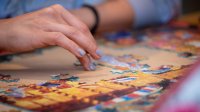Prioritizing Self-Care While Working From Home
Teachers adjusting to teaching from home while schools are closed may need to work out new routines to stay grounded.
Your content has been saved!
Go to My Saved Content.As a teacher of online courses for many years, I’ve grappled with working from home. Whether we’re planning and teaching virtually or managing projects, working from home for extended lengths of time can be challenging as work time blends into personal time. It’s too easy to slip into being on call 24/7 as we tackle emerging challenges and requests from learners anywhere and at any time.
But setting boundaries that separate work time from personal time is only a first step. To help and support others, we must become avid caretakers of ourselves.
Tending to our personal health seems important but also really difficult in situations like the current pandemic, when our time feels consumed with urgent work issues. We may feel that if we don’t get a task done, our students will suffer or programs will fail. However, if we become mentally exhausted, overtired, or drained of energy, we risk a complete shutdown mentally or physically—and at that point, no tasks will get done.
Fortunately, there are many ways that we can take care of ourselves so that we can meet the needs of others from home. The following are my suggestions for personal care and sharing with others. They are just suggestions: The most important thing is to think about the three areas—physical, mental, and social care—and do what works best for you and what you know you’ll be able to do regularly.
Physical Care: Sleep and Exercise
Tending to basic needs is important for managing stress and replenishing the energy reserves needed for tackling tasks. Numerous studies reinforce the value of adequate sleep—seven to eight hours a night for adults. One value of sleep is that it helps “maintain many vital functions” of the body, giving cells and tissues worn out by daily life time to recover, according to a research review by the Division of Sleep Medicine at Harvard Medical School.
Pair sleep with good eating habits and an exercise routine. It’s no secret that exercise can promote good sleep, as well as provide the energy needed to perform throughout the day.
Simple ideas for getting better sleep and regular exercise include:
- Maintain a routine that includes a consistent bedtime. Plan to get the rest you need so that each day you can better address your students’ needs.
- Explore sleep apps that offer real-time data regarding your sleep hours and patterns. Apps vary in accuracy, but they may capture a picture of your depth of sleep and wakefulness. The site Tom’s Guide offers an updated list of sleep apps. Sleep Cycle is my current go-to. Some fitness bands include sleep tracking.
- Establish an exercise schedule. This could include quick successes such as a walk or bike ride. I sometimes walk up and down the stairs in my house for 30 minutes or ride a stationary bike. Too busy? Set aside 15 or 20 minutes a day to walk or pace inside or outside.
- Try out fitness apps like DownDog and Peloton, YouTube videos, or fitness console games like Just Dance or Ring Fit Adventure. An extra feature of many fitness apps is the ability to document your food intake, which can be important especially if you’re concerned about stress eating.
Mental Care: Mindfulness and Learning
Set up blocks of time for work and family—but also for yourself. Loved ones see you at home working and naturally want your time. Share meals and walks, or other breaks from work, but while family and work colleagues both need your attention, protecting some personal time can help you recharge and be present for them.
Schedule activities that promote calm: meditating, growing spiritually, doing yoga, completing puzzles, or playing digital or physical games. I play Minecraft to relax and subconsciously generate ideas for creative learning. There are helpful apps that support a Zen state of mind—my favorite is Calm.
Try to keep learning by reading articles, listening to podcasts or favorite playlists, and watching instructional videos. Growing your professional practice and hobbies is valuable to rejuvenating yourself.
Social Care: Stay Connected With Others
Teachers are generally very able to keep track of time in the classroom, but we may be more challenged when working at home. Between lesson planning, researching learning experiences, and attending professional meetings, it’s possible to forget to eat and stay connected with friends and family. Since a strength of virtual learning is access to the world, use those same resources for personal growth.
Stay in contact with family and friends by using video conference tools like Zoom, Google Hangout, Skype, WhatsApp, and FaceTime. Video meetings are better than a phone call—when you have a good connection—because you can see the people. Communication is more than voice—it benefits from facial expressions and other visual cues.
Have meals and conversations online with family and friends. Every Tuesday, my family has lunch with my parents using FaceTime or Zoom on a phone or tablet. Seeing each other and sharing updates really lifts my parents’ and my kids’ spirits. There are other avenues for socializing at a distance: Participate in discussion groups or book clubs. You might really benefit from seeing a smile, even if it’s just on the screen. Social distancing doesn’t have to mean social isolation.
We are role models for our students and our children, and we can set an example and practice what we teach about lifelong learning—which is now more important than ever. Managing our physical, mental, and social well-being can give us the energy to be present to those we are responsible for and set an example for them of how to cope with our tough current situation.
